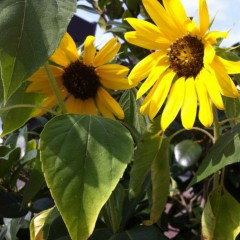「どこか寄って来ましたか」と私がいつもお越しになるお客様にお聞きします。
「善光寺さんに」 あっ、牛に引かれたね。
とか
「戸隠」 やはり、奥社へ行く途中の杉並び木は自然の力が感じられて、人気だね。特に、去年からはパワースポットブームで駐車場が溢れているぐらい。
又は、今年の人気のは:
「わさびアイスを食べた」 朝の連続ドラマ「おひさま」の影響で、安曇野(とのわさび農園)がヒットです。撮影現場として使われた奈良井宿も時々聞きます。
そして、この夏は3.11の津波の影響で、海じゃなくて山へ行く筒で
「黒部ダム」とか「千畳敷カール」、「美ヶ原」、「志賀高原」、「菅平」も多い。
その中で、初めて聞いたのは1つがあった: 山梨県のひまわり。
行ってきたお客様は撮った写真も見せてくれた。確かに、綺麗なのは綺麗で、ひまわりの特徴で花は全部が同じ方向に向いていた。
聞いたら、ひまわり畑は別に種の生産の為じゃなく(このアメ人には残念: ひまわりの種はサラダにかけたら美味しい!)、油の為に程広くないし、あくまで観光客の為だけだそうです。
他の観光地(例えばわさび農園や蕎麦王国代表の善光寺、この近くのあんずの里)にそれぞれの特徴のソフトアイスが必ずある(わさびアイス、そばアイス、あんずアイスなど)。ですから、冗談で「ひまわりアイスはあったか」と聞いたら、以前はあったと。
ひまわりアイス?どんな味か想像付かない。
一つの13年前の事を思い出しました。私と亀清の若女将がもっと若い時に、欧州旅行しました。その時にパリから電車でロワール川沿いのAmboiseしに行って、レンタサイクルでChenonceaux城を見に行きました。途中でひまわり畑を通りました。目が届くまでずっとひまわりだった。ものすごく感動しました。
写真を撮っている観光客は一人もいなかった。
山梨のひまわり畑に行った事がないけど、その観光の為に作った狭い畑で喜ばれている観光客がAmboiseの畑を見たら、きっと鼻血が出るでしょう。
日本の観光世界はそういう面白い所がある。どう見ても「作られた」観光地は人気(ひまわり畑をわざわざ作るなら、種ぐらい作ってよ!)、注目すべきなところが無視されている(この千曲市で森将軍塚とか稲荷山の古い町並みなど、沢山ある!)。
まあ、私は旅館の若旦那として、お客さんに観光情報をあげる中で観光臭い所を避けて、穴場的な所をなるべく案内するのが好きです。
"Did you stop anywhere on your way here?" is what I always ask our guests on arrival.
"Zenkoji Temple" is always the most popular. There is a legend about an ox pulling an old lady to Zenkoji. That ox must be busy.
"Togakushi" is a big one, too. The massive cedar trees really convey the power of nature. In fact, perhaps they convey it too well. Lately, Togakushi's been the subject of a power spot 'boom' and is getting too crowded.
"Wasabi soft serve ice cream" is a popular answer this year, with Azumino and its wasabi fields being featured in a TV show.
Following the 3.11 earthquake and tsunami, many people are shying away from beaches and heading to the mountains. Hence the Komagatake Ropeway to Senjojiki Kaar, Kurobe Dam, Utsukushi ga hara highlands, Shiga Heights and Sugadaira have all been popular.
Today I got a reply I'd never heard before: a field of sunflowers in neighboring Yamanashi prefecture. The couple that stopped there showed me the pictures they took. The flowers were certainly pretty, and it was somewhat whimsical the way they were all facing the same direction.
According to the guests, the flowers weren't being grown for seeds, as Japanese people usually don't eat them (much to my chagrin -- I love sunflower seeds topping my salad), and the field wasn't large enough to produce oil. Apparently the field's only purpose was to attract tourists.
This reminded me of a trip Mari and I took to Europe about 13 years ago. We took the train from Paris to the Loire River Valley, stopping in Amboise and riding rental cycles to the chateau at Chenanceaux. Along the way, we rode past vast fields of sunflowers. There were sunflowers plants as far as the eye could see.
And not a single tourist taking pictures.
I've never been to the sunflower field in Yamanashi, but I have a hunch that the tourists that were pleased with that small field ever saw the amazing fields in Amboise, they'd probably start to drool in excitement.
Japan's kind of funny with its tourism spots. While places that were clearly made just for tourists (if you're going to grow sunflowers, at least sell the seeds!) are popular, places that are truly fascinating don't get the attention they deserve. (The 1600-year old burial mound in nearby Mori and the earthen-walled storehouses in Inariyama come to mind.)
As an innkeeper giving tourism advice to our guests, I try to stay away from the tourist traps, and focus on some of the under-appreciated lesser-known spots.




